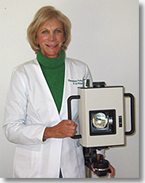What Doctors are Saying about Thermography
I am happy to offer Thermography to my patients. There is no radiation involved which is an important point for many of my patients. In utilizing this test we may be able to detect breast tumors years before it will be found by physical examination or mammography. Thermography can also be used to image other areas of the body and is especially useful in pain of musculoskeletal nature, helping you to know whether it might be necessary to have further studies, such as a CT scan or an MRI, or whether these might be unnecessary in a particular case. I'm proud to offer this cutting edge technology in my practice.
— Dr. Henry Sobo, MD, Stamford, Connecticut
Mammography fails to detect cancer in 10 to 30 percent of the women who have it. This means that one tenth to almost one third of mammography reports give you a false-negative result - they tell you there's nothing to be concerned about when there actually is. The false-positive rate is significant as well; up to 10 percent of women undergoing mammography will hear that they have breast cancer when in fact they don't. I don't know about you, but I think that's an unacceptably high error rate, especially when there's another option: thermography.
—Susan M. Lark, MD from "Woman's Wellness Today", February 2008, page 6.
from "The Foundation of Breast Cancer Prevention", Designs for Health Teleconference, October 3, 2007.
Thermography gave me an opportunity to learn more about my body and how to care for it. It helped me break through illusions and showed me that even though early signs of a problem bring up fears, they are less frightening that finding a more serious condition.
You don’t necessarily have to get breast cancer. Not if you can find early warning signs and reverse them like I did. The heat patterns on my thermogram indicated that I was at moderate risk for developing cancer in the future, so I immediately took action and reviewed my diet, supplements and lifestyle.
Five months later, my thermogram showed a great improvement.
—Nan Kathryn Fuchs, PhD, Editor of “Women’s Health” newsletter
(The following came from Dr. Fuchs’ “Life-saving Breakthrough That Goes Beyond Mammograms). For more information visit her web site, www.womenshealthletter.comAfter having 2 painful mammographies I said -never again. Later, when I wrote my doctorate thesis on breast cancer, I found out that thermography is really a better option when "things feel normal" and leave the mammography for later in case something shows in the thermo. Thermography was a relaxing and pleasant experience, especially when done by a friendly and competent person. I highly recommend it.
Why Mammography is NOT an Effective Breast Cancer Screen
The most devastating loss of life from breast cancer occurs between the ages of 30 to 50. Fortunately, you have more options available to you today to help detect breast cancer than in the past decades.
Unfortunately, education and awareness of these options and their effectiveness in detecting breast cancer at different stages in life are woefully deficient.
Beyond Mammography
In the first part of the in-depth article linked below, Beyond Mammography, Dr. Len Saputo explores the latest findings on the effectiveness and shortcomings of various detection methods used by the mainstream medical community, including mammography, clinical breast exams, ultrasound, and to a lesser extent, magnetic resonance imaging (MRIs) and PET scans.
The second part goes beyond mammography, exploring a highly advanced but much maligned detection tool for breast cancer -- breast thermography.
Breast thermography, which involves using a heat-sensing scanner to detect variations in the temperature of breast tissue, has been around since the 1960s. However, early infrared scanners were not very sensitive, and were insufficiently tested before being put into clinical practice, resulting in misdiagnosed cases.
Modern-day breast thermography boasts vastly improved technology and more extensive scientific clinical research.
In fact, the article references data from major peer review journals and research on more than 300,000 women who have been tested using the technology. Combined with the successes in detecting breast cancer with greater accuracy than other methods, the technology is slowly gaining ground among more progressive practitioners.
—Dr. Len Saputo, MD
About the Author
Dr. Len Saputo, MD, is a graduate of Duke University Medical School, and is the Founder and Director of the Health Medicine Forum, which has hosted and moderated over 350 events. He's also the Co-founder and Medical Director of the Health Medicine Institute and Health Medicine Center, and runs a private practice in Internal Medicine and Health Medicine.


